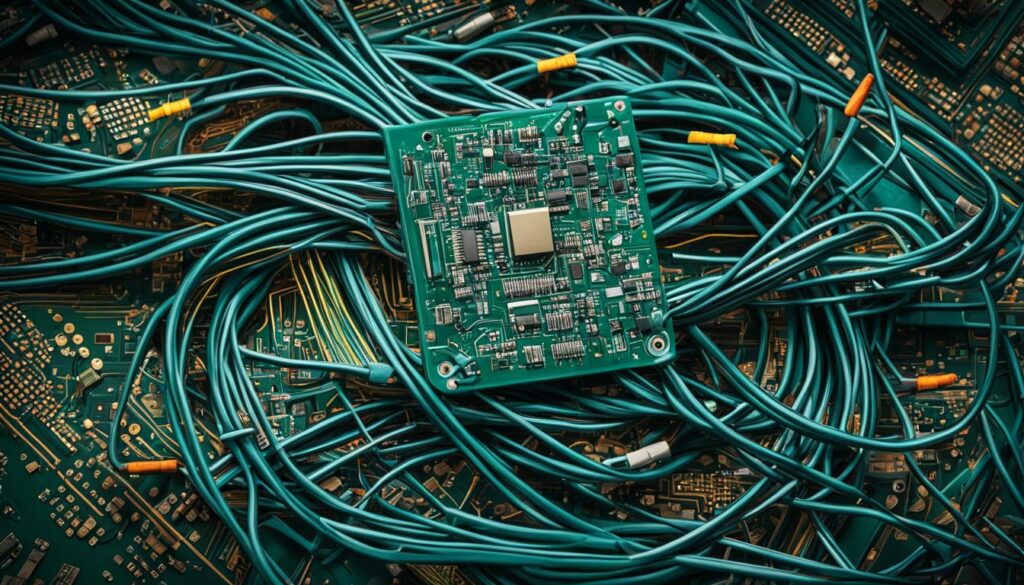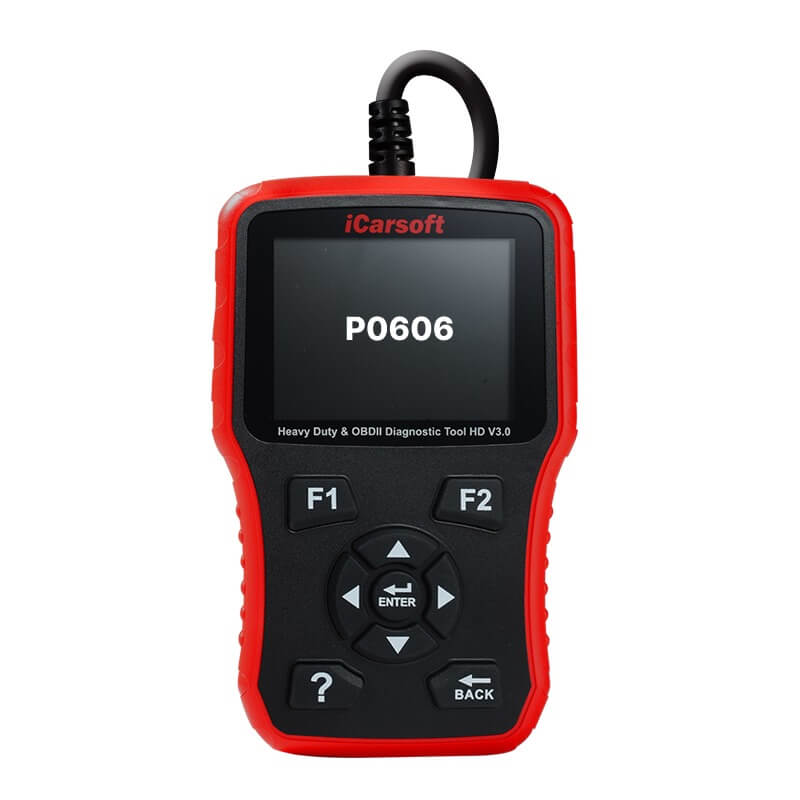P0606 – ECM Processor Fault
POSTED IN pcodes
When the check engine light turns on in a car or truck, it’s important to do diagnostic testing to determine the issue. The code P0606 indicates a processor fault in the Engine Control Module (ECM) or Powertrain Control Module (PCM). This fault can be resolved by upgrading or re-flashing the control module, but in some cases, replacement and reprogramming may be necessary. It is recommended to have a dealer or authorized repair service handle these repairs, as it requires manufacturer-level access and calibration skills. PCM/ECM repairs and replacements may also be covered under warranty.
Key Takeaways:
- P0606 signifies a processor fault in the ECM or PCM.
- Upgrading or re-flashing the control module can resolve the fault.
- Authorized repair services are recommended for handling these repairs.
- PCM/ECM repairs and replacements may be covered under warranty.
- Proper diagnostic testing is essential before attempting repairs.
Symptoms of P0606 Fault
A faulty ECM processor can cause various symptoms in a vehicle. Understanding these symptoms can help identify and address the P0606 fault promptly. Some common symptoms of P0606 include:
- Check engine light illuminated on the dashboard: One of the most common indicators of a P0606 fault is the illumination of the check engine light on the vehicle’s dashboard. This serves as a warning sign that there is an issue with the ECM processor.
- Transmission issues: A P0606 fault can lead to transmission-related problems such as stuttering, jerking, or shifting issues. These symptoms can disrupt the smooth functioning of the vehicle and affect the overall driving experience.
- Decreased gas mileage: The ECM processor plays a crucial role in engine pressure and fuel ratio control. A malfunctioning ECM can result in decreased gas mileage, leading to more frequent visits to the fuel station.
- Potential engine or transmission damage: If left unresolved, a P0606 fault can have serious consequences for the engine and transmission. Ignoring the fault can lead to further damage and potentially costly repairs.
Addressing the symptoms of a P0606 fault promptly is crucial to prevent further damage and resolve the issue efficiently. Seeking professional assistance and diagnostic testing can help identify the underlying cause and determine the best course of action for repair.

References:
– National Highway Traffic Safety Administration (NHTSA)
– Repair Pal
Buy tested tuning file for Adblue / EGR / DPF / Adblue off now!
Troubleshooting P0606
When encountering a P0606 fault, it is important to accurately diagnose and resolve the issue. Troubleshooting involves determining whether the problem lies with the Engine Control Module (ECM) or the wiring. By performing the following steps, you can identify potential causes and take appropriate action to resolve the P0606 fault:
- Check the ECM wiring: Inspect the wires connecting the ECM to other devices for signs of fraying, corrosion, or loose connections. This can be done visually or by using specialized diagnostic tools to measure the electrical continuity.
- Test the O2 sensors: Faulty oxygen (O2) sensors can contribute to the P0606 fault. Perform diagnostic tests on the O2 sensors to ensure they are functioning properly and providing accurate readings.
- Inspect the control area network (CAN) bus: The CAN bus is responsible for communication between various modules in the vehicle. Check for any issues or malfunctions in the CAN bus that may be affecting the ECM’s performance.
It is highly recommended to consult a professional technician with expertise in ECM troubleshooting or use specialized diagnostic tools for accurate diagnosis and resolution of the P0606 fault. They will have the necessary knowledge and equipment to handle the ECM and its related components.
By following the troubleshooting steps mentioned above, you can effectively resolve the P0606 issue and ensure the proper functioning of the ECM and the vehicle as a whole.

Example Troubleshooting Process
| Possible Cause | Troubleshooting Steps |
|---|---|
| Frayed or corroded ECM wiring | 1. Inspect the wiring connections and repair any frayed or corroded wires. 2. Test the continuity of the repaired wiring to ensure a proper connection. |
| Malfunctioning O2 sensors | 1. Use a diagnostic tool to check the O2 sensor readings. 2. Replace any faulty sensors and retest to confirm accurate readings. |
| Issues with the CAN bus | 1. Perform diagnostic tests on the CAN bus to identify any malfunctions. 2. Repair or replace any faulty components within the CAN bus system. |
Repairing the P0606 Fault
Repairing a P0606 fault can be a complex process that requires mechanical and electrical knowledge. When diagnosing the issue, it is crucial to determine if the problem lies with the ECM. In some cases, the ECM may need to be replaced to resolve the fault. Alternatively, replacing the wiring harness that connects the ECM to the CAN bus can also be a viable solution.
It is essential to follow proper repair procedures to ensure that the replacement or repairs are done correctly and effectively address the P0606 fault. By doing so, you can prevent further complications and avoid unnecessary expenses in the future.
Seeking Professional Assistance
Given the complexity of repairing the P0606 fault, seeking professional assistance or consulting a reputable repair service is strongly recommended. Experienced technicians have the necessary expertise and resources to diagnose the issue accurately and carry out the repairs with precision.
Quality Repair Options
- ECM Replacement: If the fault lies within the ECM, replacing it with a new or refurbished unit can effectively resolve the P0606 fault. This ensures that you have a reliable and functioning control module for optimal vehicle performance.
- Wiring Harness Replacement: In certain cases, the fault may be attributed to a faulty wiring harness. Replacing the wiring harness that connects the ECM to the CAN bus can eliminate any issues stemming from wiring malfunctions.
By exploring these repair options, you can address the P0606 fault and restore your vehicle’s proper functionality. Remember to consult with professionals to ensure accurate diagnosis and reliable repairs.
P0606 – Severity and Consequences
The P0606 fault code indicates a serious issue with the ECM processor. If left unresolved, this fault can lead to various consequences, including:
- Transmission problems: The malfunctioning ECM processor can cause erratic shifting, slippage, or difficulty in engaging gears, compromising the vehicle’s drivability and safety.
- Decreased fuel efficiency: A faulty ECM processor may disrupt the engine’s fuel management system, resulting in inefficient combustion and reduced fuel economy.
- Potential engine or transmission damage: Ignoring the P0606 fault can have long-term consequences, such as increased wear and tear on the engine and transmission components. This can lead to costly repairs or even complete failure of these vital systems.
Given the severity of the P0606 fault, it is crucial to address it promptly and seek professional assistance to prevent further damage and ensure the proper functioning of your vehicle.
It is recommended to consult a trusted automotive technician or a reputable repair service to accurately diagnose the issue and perform the necessary repairs or replacements. Ignoring the P0606 fault can result in potentially expensive repairs and compromised vehicle performance. By taking immediate action, you can avoid further complications and maintain the reliability and safety of your vehicle.
Conclusion
Dealing with a P0606 ECM processor fault can be challenging, and professional assistance is recommended. If professional help is unavailable, there is an alternative solution available. Our company offers the permanent removal of the P0606 fault by uploading the Engine Control Unit (ECU) file to our portal. This eliminates the need for extensive repairs or replacement of the ECM. It is important to take prompt action when encountering a P0606 fault to maintain the vehicle’s performance and avoid costly repairs.
FAQ
What does the P0606 code indicate?
The P0606 code indicates a processor fault in the Engine Control Module (ECM) or Powertrain Control Module (PCM).
What are some symptoms of a P0606 fault?
Common symptoms of a P0606 fault include a check engine light illuminated on the dashboard, transmission issues, decreased gas mileage, and potential engine or transmission damage.
How do I troubleshoot a P0606 fault?
Troubleshooting a P0606 fault involves checking the wiring for any issues, testing O2 sensors, and evaluating the control area network (CAN) bus.
How can I repair a P0606 fault?
Repairing a P0606 fault may involve upgrading or re-flashing the ECM, replacing the ECM, or replacing the wiring harness connecting the ECM to the CAN bus.
What are the consequences of ignoring a P0606 fault?
Ignoring a P0606 fault can lead to transmission problems, decreased fuel efficiency, and potential damage to the engine or transmission.
Do I need professional assistance for a P0606 fault?
It is recommended to seek professional assistance from a dealer or authorized repair service for P0606 faults as they require specialized skills and equipment. Alternatively, our company offers a solution by permanently removing the P0606 fault through ECM file upload.


